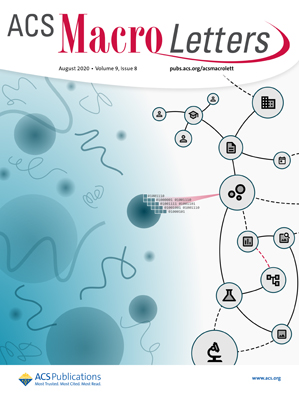Cholesteric Contact Lenses for Diabetics-Related Noninvasive Glucose Monitoring and Eye Healthcare.
IF 5.1
Q1 POLYMER SCIENCE
引用次数: 0
Abstract
Blood sugar monitoring has crucial significance for diabetes mellitus diagnosis, and noninvasive continuous detection methods are the future development trend. Among various noninvasive detection methods, glucose detection in tears has the advantages of a high level of subject compliance, minimal pollution, and accuracy. However, sensors used for detecting glucose concentration in tears usually embed noble microelectrical components into contact lenses, making the process complicated and costly, and easily cause environmental pollution and resource wastage. Here, we propose a construction strategy for contact lenses based on the cellulose nanocrystal (CNC) cholesteric structure, preparing products that change color according to the concentration of glucose. In addition, the surface of the contact lenses can be loaded with drugs for adjuvant treatment of diabetic eye complications. Contact lenses offer advantages such as a fast response speed (<240 s), high sensitivity with distinct colors at specific glucose concentrations (green at 0 mM, yellow at 5 mM, and red at 10 mM), and a reversible response process. Furthermore, they exhibit good biocompatibility (90% cell viability by CCK-8 assay) and biodegradability (complete biodegradation in soil within 120 days). CNC cholesteric contact lenses realize noninvasive, wearable continuous glucose detection, providing a new strategy for health monitoring of diabetics.抗胆固醇隐形眼镜用于糖尿病相关的无创血糖监测和眼部保健。
血糖监测对糖尿病的诊断具有重要意义,无创连续检测方法是未来的发展趋势。在各种无创检测方法中,泪液中葡萄糖检测具有受试者依从性高、污染小、准确性高等优点。然而,用于检测泪液中葡萄糖浓度的传感器通常将贵重的微电子元件嵌入隐形眼镜中,过程复杂且成本高,容易造成环境污染和资源浪费。在此,我们提出了一种基于纤维素纳米晶体(CNC)胆甾化结构的隐形眼镜构建策略,制备出根据葡萄糖浓度变化颜色的产品。此外,隐形眼镜表面可装载药物,辅助治疗糖尿病眼并发症。隐形眼镜的优点是响应速度快(<240秒),在特定葡萄糖浓度下具有不同颜色的高灵敏度(0毫米时为绿色,5毫米时为黄色,10毫米时为红色),并且具有可逆的响应过程。此外,它们具有良好的生物相容性(CCK-8测定细胞存活率为90%)和生物降解性(在土壤中120天内完全生物降解)。数控胆固醇隐形眼镜实现了无创、可穿戴的血糖连续检测,为糖尿病患者的健康监测提供了一种新的策略。
本文章由计算机程序翻译,如有差异,请以英文原文为准。
求助全文
约1分钟内获得全文
求助全文
来源期刊
CiteScore
10.40
自引率
3.40%
发文量
209
审稿时长
1 months
期刊介绍:
ACS Macro Letters publishes research in all areas of contemporary soft matter science in which macromolecules play a key role, including nanotechnology, self-assembly, supramolecular chemistry, biomaterials, energy generation and storage, and renewable/sustainable materials. Submissions to ACS Macro Letters should justify clearly the rapid disclosure of the key elements of the study. The scope of the journal includes high-impact research of broad interest in all areas of polymer science and engineering, including cross-disciplinary research that interfaces with polymer science.
With the launch of ACS Macro Letters, all Communications that were formerly published in Macromolecules and Biomacromolecules will be published as Letters in ACS Macro Letters.

 求助内容:
求助内容: 应助结果提醒方式:
应助结果提醒方式:


